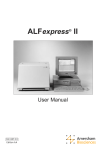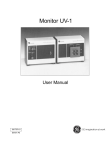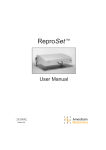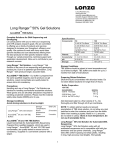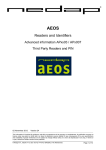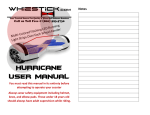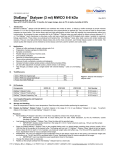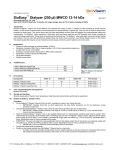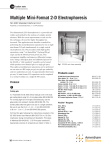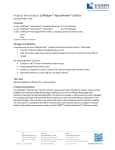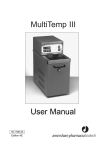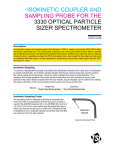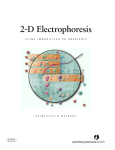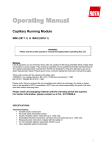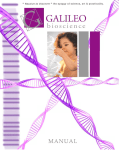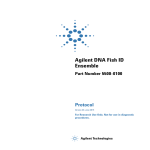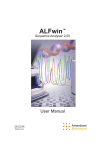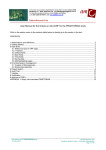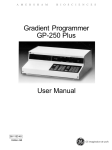Download ALFexpress® II Cooler Kit User Manual
Transcript
ALFexpress¨ II Cooler Kit User Manual 18-1127-14 Edition AA Important user information Read the entire instructions to fully understand the safe use of ALFexpress II Cooler Kit. Safety symbols Safety symbols used on the equipment or in the instructions. Meaning: Consult the instruction manual to avoid personal injury or damage to the product or other equipment. Warning! The Warning sign calls attention to the necessity to follow an instruction in detail to avoid personal injury. Do not proceed until the instructions are clearly understood and all stated conditions are met. Caution! The Caution sign calls attention to an instruction or condition that should be followed to avoid damage to the product or other equipment. Do not proceed until the instructions are clearly understood and all stated conditions are met. Note: The Note sign indicates information important for trouble-free or optimal use of the product. Warranty and liability statements Amersham Biosciences AB guarantees that the product delivered has been thoroughly tested to ensure that it meets its published specifications. The warranty included in the conditions of delivery is valid only if the product has been installed and used according to the instructions supplied by Amersham Biosciences AB. Amersham Biosciences AB shall in no event be liable for incidental or consequential damages, including without limitation lost profits, loss of income, loss of business opportunities, loss of use or other related exposures, however caused, arising from the faulty or incorrect use of the product. Amersham Biosciences reserves the right to make changes in the specifications without prior notice. Trademarks ALFexpress®‚ MultiTemp®, AlleleLinks™ and ALFwin™ are the exclusive trademarks of Amersham Biosciences AB. In view of the risk of trademark degeneration, it is respectfully suggested that authors wishing to use these designations refer to their trademark status at least once in each article. Copyright 1998 Amersham Biosciences AB All rights reserved. No part of this publication may be reproduced, stored in a retrieval system or transmitted in any form by any means, without permission in written form from the company. Should you have any comments on this product, we will be pleased to receive them at: Amersham Biosciences SE-751 84 Uppsala Sweden Contents 1. Introduction . . . . . . . . 2. Safety information . 2.1 Safety precautions 2.2 Safety standards . . . . . . . . . . . . . . . . . . . . . . . . . . . . . . . . . . . . . . . . . . . . . . . . . . . . . . . . . . . . . . . . . . . . . . . . . . . . . . . . . . . . . . . . . . . . . . . . . . . . . . . . . . . . . . . . . . . . . .3 .4 .4 .5 3. Product description . . . . . . . . . . . . . . . . . . . . . . . . . . . . . . . . . 6 3.1 General working principles . . . . . . . . . . . . . . . . . . . . . . . 6 3.2 Water circulation switch . . . . . . . . . . . . . . . . . . . . . . . . . 6 3.3 Insulation cover for the gel cassette . . . . . . . . . . . . . . . . . 7 3.4 Materials. . . . . . . . . . . . . . . . . . . . . . . . . . . . . . . . . . . . . 7 4. Unpacking and installation . . . . . . . . . . . . . . . . . . . . . . . . . . . 8 5. Operation . . . . . . . . . . . . . . . . . . . . . . . . . . . . . . . . . . . . . . . 10 5.1 External cooling mode . . . . . . . . . . . . . . . . . . . . . . . . . . 10 5.2 Prepare the gel cassette . . . . . . . . . . . . . . . . . . . . . . . . . 10 5.3 Prepare the polyacrylamide gel . . . . . . . . . . . . . . . . . . . . 10 5.4 Prepare the Cy-5 labelled PCR products . . . . . . . . . . . . . 11 5.5 Start a SSCP run . . . . . . . . . . . . . . . . . . . . . . . . . . . . . . 11 5.6 End the run . . . . . . . . . . . . . . . . . . . . . . . . . . . . . . . . . . 13 5.7 General recommendations for SSCP . . . . . . . . . . . . . . . . 13 5.8 Running at low temperature in humid environments . . . . 15 6. Maintenance . . . . . . . . . . . . . . . . . . . . . . . . . . . . . . . . . . . . . 17 7. Trouble-shooting . . . . . . . . . . . . . . . . . . . . . . . . . . . . . . . . . . 18 8. Technical specifications . . . . . . . . . . . . . . . . . . . . . . . . . . . . . 19 9. Ordering information . . . . . . . . . . . . . . . . . . . . . . . . . . . . . . 20 1 2 1. Introduction 1. Introduction ALFexpress®II Cooler Kit allows the external thermostatic circulator MultiTemp III to be connected to ALFexpress® II. The operator can then choose between internal control of water circulation in the sequencer, which gives a temperature range of 4060 °C, or external cooling control using MultiTemp III, which gives a temperature range of 4-40 °C. Temperatures in the range 4060 °C are suitable for sequencing. Controlled temperatures between 4-40 °C make ALFexpress II suitable for techniques such as Single Strand Conformation Polymorphism (SSCP), heteroduplex analysis and dideoxy fingerprinting (ddF). 3 2. Safety information 2. Safety information 2.1 Safety precations w These instructions should be used together with the ALFexpress II User Manual and the MultiTemp III User Manual. Warning! ALFexpress II Cooler Kit must be installed by Amersham Biosciences personnel only. Warning! The maximum working temperature of the ALFexpress II Cooler Kit is 40 °C. As a safety precaution, set the temperature limit dial on the rear of MultiTemp III to 50 °C (See the MultiTemp III User Manual.). Warning! Always use gloves and goggles and work in a fume hood when using Bind-Silane. It is toxic and highly volatile. Warning! Wear gloves, goggles, a laboratory coat and work in a fume hood when using acrylamide, bisacrylamide and TEMED. Avoid contact with dust from acrylamide, bisacrylamide and fumes from TEMED. These chemicals are neurotoxic. TEMED is also extremely flammable. Keep it away from heat, sparks and flames. Warning! Wear goggles, a laboratory coat, gloves and work in a fume hood when using formamide. Formamide irritates eyes and skin and is harmful when inhaled. It may also cause birth defects. Caution! The maximum allowed water pressure for the gel cassette is 0.2 bar. Higher pressure may break the gel cassette after a period of use. MultiTemp III gives 0.32 bar pressure. The Kit contains a shunt to reduce the pressure to a suitable level. Caution! Ensure that the shunt supplied in the Kit is fitted to the rear of MultiTemp III. (See Unpacking and installation.) Caution! The gel cassette should not be exposed to rapid temperature changes during the run or during cleaning. The gel cassette should under no circumstances be placed in hot water. Use tepid water only for cleaning. 4 2. Safety information Caution! Before turning the water circulation switch, ensure that the temperatures of the internal circulation and external cooling are about the same. Never switch from hot internal circulation to external cooling, especially if MultiTemp III has already reached a low temperature. The gel cassette may break due to thermal tension. Never switch from low temperature external cooling to internal circulation. Caution! Turn the water circulation switch fully from one end position to the other end position (external coolinginternal circulation). Never leave the switch in an intermediate position. Caution! Check the water level in both ALFexpress II and MultiTemp III each week. Fill with water when needed. (See ALFexpress II User Manual, and MultiTemp III User Manual.) Caution! No other coolant than water should be used. Other coolants may destroy the gel cassette and may also cause autofluorescence. 2.2 Safety standards ALFexpress II Cooler Kit maintains the EN 61010-1 safety standard of ALFexpress II and MultiTemp III. 5 3. Product description 3. Product description 3.1 General working principles ALFexpress® II Cooler Kit makes it possible to connect an external thermostatic circulator, MultiTemp III, to ALFexpress II. By turning the water circulation switch, the operator can choose between internal circulation (40-60 °C) or external cooling (4-40 °C). See Figure 1. Fig. 1. Water circulation switch. Fig. 2a. Turning the water circulation switch to white (Internal Circulation). ALFexpress II controls the water temperature. 3.1 Water circulation switch 6 Fig. 2b. Turning the water circulation switch to black (External Cooling). MultiTemp III controls the water temperature. The water circulation switch is positioned on the top of ALFexpress II. (see Figure 1). Turning the switch to the internal circulation position disconnects MultiTemp III and the ALFexpress II temperature control is operational (see Figure 2a). The temperature range then extends to 20 °C above the ambient temperature up to 60 °C. This mode is suitable for sequencing and fragment analysis. Turning the switch to the external cooling position disconnects the internal circulation and connects the external thermostatic circulator MultiTemp III, which then controls the temperature (see Figure 2b). 3. Product description This external cooling mode is appropriate for SSCP analysis and other techniques that benefit from controlled temperatures below 40 °C. The temperature of coolant circulated to the gel cassette is measured and monitored by the ALFwin Control module within the application software ALFwin Sequence Analyser 2.00 or ALFwin Fragment Analyser 1.00. ALFwin checks if internal or external water circulation is used. Caution! Before turning the water circulation switch, ensure that the temperatures of the internal circulation and external cooling are about the same. Never switch from hot internal circulation to external cooling, especially if MultiTemp III has already reached a low temperature. The gel cassette may break due to thermal tension. Never switch from low temperature external cooling to internal circulation. Caution! Turn the water circulation switch fully from one end position to the other end position (external coolinginternal circulation). Never leave the switch in an intermediate position. 3.3 Insulation cover for the standard gel cassette The insulation cover (Figure 3) is put on the front of the standard gel cassette (Figure 4) to avoid condensation on the cold cassette. The insulation cover is only needed in humid ambient conditions when condensation may occur on the gel cassette and run down into the lower buffer reservoir. Fig. 3. Insulation cover for the gel cassette. Fig. 4. Positioning the insulation cover on the gel cassette. 3.4 Materials Item Tubing T and Y connectors Tubing insulation Switch Insulation cover for the gel cassette Material Silicone Polypropylene Nitrile rubber (NBR) and PVC Polyamide PVC laminate with polyethylene insulation 7 4. Unpacking and installation 4. Unpacking and installation Warning! ALFexpress II Cooler Kit must be installed by Amersham Biosciences service personnel only. ALFexpress II Cooler Kit is developed for use with the MultiTemp III thermal circulator. Install MultiTemp III according to the instructions in the MultiTemp III User Manual. Warning! The maximum working temperature of the ALFexpress II Cooler Kit is 40 °C. As a safety precaution, set the temperature limit dial on the rear of MultiTemp III to 50 °C. (See the MultiTemp III User Manual.) Caution! The maximum allowed water pressure for the gel cassette is 0.2 bar. Higher pressure may break the gel cassette after a period of use. MultiTemp III gives 0.32 bar pressure. The Kit contains a shunt to reduce the pressure to a suitable level. The shunt consists of one Y and one T connector. The T connector must be fitted to the outlet of MultiTemp III and the Y connector to the inlet (see Figure 5). The shunt creates the same pressure and flow as the ALFexpress II internal circulator. MULTITEMP III INLET OUTLET Fig. 5. How to arrange the shunt with the T and Y shaped connectors. 8 4. Unpacking and installation Caution! Check the water level in both ALFexpress II and MultiTemp III each week. Fill with water when needed. (See ALFexpress II User Manual, and MultiTemp III User Manual.) Caution! No other coolant than water should be used. Other coolants may destroy the gel cassette and may also cause autofluorescence. 9 5. Operation 5. Operation 5.1 External cooling mode Turn the water circulation switch on top of the ALFexpress II to external cooling. Caution! Before turning the water circulation switch, ensure that the temperatures of the internal circulation and external cooling are about the same. A temperature shock may destroy the gel cassette. Caution! Turn the water circulation switch fully from one end position to the other end position (external coolinginternal circulation). Never leave the switch in an intermediate position. MultiTemp III is now controlling the temperature in the gel cassette. Caution! Check the water level in both ALFexpress II and MultiTemp III. Fill with water when needed. (See ALFexpress II User Manual, and MultiTemp III User Manual.) No other coolant than water should be used. Other coolants may destroy the gel cassette and may also cause autofluorescence. Note: 5.2 Prepare the gel cassette When external cooling is used, the yellow temperature indicator light on the ALFexpress II front panel flashes slowly. Clean the gel cassette and treat it with Bind-Silane. Assemble the cassette according to the ALFexpress II User Manual, Operation, assembling the gel cassette. Warning! Always use gloves and goggles and work in a fume hood when using Bind-Silane. It is toxic and highly volatile. 5.3 Prepare the polyacrylamide gel 10 Use PlusOne Chemicals supplied by Amersham Biosciences for all reagents and gels. This is especially important if the polyacrylamide gels are to be used for more than one run (see 5.7). 5. Operation Warning! Wear gloves, goggles, a laboratory coat and work in a fume hood when using acrylamide, bisacrylamide and TEMED. Avoid contact with dust from acrylamide, bisacrylamide and fumes from TEMED. These chemicals are neurotoxic. TEMED is also extremely flammable. Keep it away from heat, sparks and flames. 10 X TBE Buffer 0.89 M Tris (107.7 g) 0.89 M Boric acid (55 g) 20 mM EDTA (7.55 g) Make up to 1000 ml with MilliQ water. Acrylamide stock solution T30C1 29.7 g acrylamide IEF PlusOne 0.3 g bis-acrylamide PlusOne Make up to 100 ml with MilliQ water. Gel casting solutions Acrylamide gel T10C1 1 X TBE 23.3 ml Acrylamide stock solution T30 C1 7.0 ml 10 X TBE buffer 39.4 ml MilliQ Water 20 µl TEMED 0.4 ml 10% ammonium persulphate solution Acrylamide gel T6C1 1 X TBE 14.0 ml Acrylamide stock solution T30 C1 7.0 ml 10 X TBE buffer 48.6 ml MilliQ Water 20 µl TEMED 0.4 ml 10% ammonium persulphate solution Mix the acrylamide stock solution, the 10 X TBE buffer and MilliQ Water by gentle swirling. Add Temed and the ammonium persulphate solution. Swirl gently to mix without incorporating air and immediately fill the gel cassette according to the instructions in the ALFexpress II User Manual. 5.4 Prepare the Prepare fluorescent DNA fragments using Cy5*-labelled primers in the PCR** reaction. Using both primers Cy5-labelled maximise the Cy5-labelnumber of detected mutations. Store the PCR products at -20 °C. led PCR products * Cy5 is the trademark of Biological Detection Systems, Inc. ** PCR polymerase chain reaction. The PCR process is covered by U.S. patents 4,683,195 and 4,683,202 owned by Hoffmann-La Roche Inc. Use of the process requires a license. 11 5. Operation 5.5 Start a SSCP run Start ALFwin software (see ALFwin Sequence Analyser manual or ALFwin Fragment Analyser manual). When using the standard gel cassette with 200 mm separation distance and 0.5 mm spacers, create a casebook in ALFwin with the following running conditions: 1200 volts, 40 mA, 35 W, 800 mins and sampling interval 2. The set temperature is registered in ALFwin. The run log will register the external cooling temperature even though MultiTemp III is now controlling the temperature. When using the short gel cassette with 80 mm separation distance and 0.3 mm spacers, create a casebook in ALFwin with the following running conditions: 800 volts, 25 mA, 15 W, 600 mins and sampling interval 2. Fit the gel cassette into the instrument. Check that the water temperature of MultiTemp III is close to the temperature of the gel cassette. Connect the cooling water to the gel cassette as normal. Start MultiTemp III and set the temperature. Fill the buffer reservoirs with 1xTBE buffer. When using low running temperature, pre-equilibrate the buffer to the same temperature to save time and reduce condensation on the gel cassette. Prepare the SSCP samples When MultiTemp III reaches the set temperature indicated on the display, start preparing the samples by mixing the following components: 1.5 µl of the PCR product. 1.5 µl Cy5 size marker, Sizer 100 bp (shorter than the PCR fragment). 1.5 µl Cy5 size marker, Sizer 300 bp (longer than the PCR fragment). 4.5 µl denaturing solution (see below). Warning! Wear goggles, a laboratory coat, gloves and work in a fume hood when using formamide. Formamide irritates eyes and skin and is harmful when inhaled. It may also cause birth defects. Denaturing solution Formamide PlusOne 0.01% bromophenol blue Equilibrate for 4 minutes at 95 °C. Quickly place the samples on ice or in a ice water bath. Allow to cool for a few minutes. Apply the sample on the gel and connect the electrodes. Immediately start the run according to the ALFexpress II User Manual. 12 5. Operation Samples can be stored at -20 °C and re-run after equilibrating at 95 °C for 4 minutes and cooling for a few minutes. Sample volumes are: Standard cassette, 2.5 µl. Short cassette, 1.5 µl. 5.6 End the run On completion of the run, the laser beam and the high voltage switch off automatically. If any post-run actions have been selected, these will be performed automatically. ALFexpress II and MultiTemp III may now be switched off. If the gel has been made with the recommended chemicals, it can be used for more than one SSCP run (see 5.7). Before next run, the buffer must be discharged and fresh buffer added. To discharge the gel and clean the gel cassette, see the ALFexpress II User Manual, Operation, Disassembly of the gel cassette. Caution! Always use tepid water to clean the cassette. Hot water may heat the water in the gel cassette, which may expand and brake. To evaluate the separation, use ALFwin Fragment Analyser or AlleleLinks software. 5.7 General recommendations for SSCP Samples Use both primers Cy5-labelled to maximise the number of mutations detected. Store the fragments at -20 °C. The optimal fragment length for detecting mutations is in the range 100- 400 bp. The sensitivity of SSCP for detecting mutations is also dependent on the position of the mutation on the fragment. Optimising and standardising the PCR reaction and sample preparation are prerequisites for obtaining a characteristic, reproducible pattern for the wild type and well-defined mutations. Gel composition Choose the gel composition according to fragment size: • Below 200 bp use T10C1. • Above 200 bp use T6C1. Generally, a high concentration of acrylamide (around T10) and a low concentration of cross-linker C1 improves the detection of point mutations. A low concentration of acrylamide reduces the running time. A low concentration of bis-acrylamide C1 improves the transparency of the gel and gives high laser values. Above C4, the gel becomes opaque and absorbs the laser beam, which results in too low laser values. Concentrations below C1 can be used but the mechanical strength of the gel then becomes critical. Additives like glycerol and ethylene glycol up to 10 % concentration may in some cases improve the detection of mutations. 13 5. Operation Gel stability, number of runs/gel Gels can be run repeatedly due to the low running temperature (below 20 °C). Up to 10 analyses over 10 days can be run on the same gel without any negative effects on the results. However, new electrode buffer must be used for each run. Gels containing low molecular weight additives, such as urea and glycerol, can only be used once due to loss of the additives through diffusion. Influence of temperature Temperature has a great influence on the separation patterns and thus the ability to detect point mutations. Separation patterns change continuously with temperature but major changes also occur at distinct temperature points. It seems that each fragment has its own temperature dependence. Even though the + and - strands are better separated at a low temperature (+4 °C), most point mutations are more easily detected in the temperature range 10-18 °C. To find the temperature optimum where the most mutations are revealed, run a limited number of samples at different temperatures in the range 10-18 °C. Alternatively, run all samples at two temperatures. Ionic strength and pH Increasing the ionic strength from 0.089 M TBE buffer to 0.134 M TBE buffer or lowering the pH using 0.1 M Tris-Mes-EDTA buffer pH6.8 (same buffer in gel and buffer vessels) may improve the detection of some point mutations but could also obstruct the detection of others. A higher ionic strength increases the conductivity in the gel and running at the same mA results in a lower voltage and longer running time. Standard or short gel cassette The standard gel cassette gives better resolution, especially for short fragments, but it takes two or three times as long to run as the short gel cassette. Table 1 shows typical analysis times for 200 bp fragments using the standard and short gel cassettes with gel T10C1 and gel T6C1. Gel type Standard cassette Short cassette T10C1 T6C1 8 hours 4 hours 3 hours 1.5 hours Table 1. Analysis time in hours using different cassettes and gel types. Sample: 200 bp long fragment. 14 5. Operation Interpretation of peaks The separation patterns are evaluated by ALFwin Fragment Analyser or AlleleLinks software. The first peak represents the primer. The second peak is preferably the added size marker. The third peak represents the double-stranded DNA. After these three peaks, the single-stranded DNA should appear followed by the added long size marker. The primer peak can be identified by running one SSCP analysis on a PCR reaction without template DNA. The double-stranded peak can be identified by running one SSCP analysis without denaturing the PCR products. In an ideal system, the homozygote wild type should give two peaks (one for each strand) and the heterozygote four peaks. However, more peaks may appear depending on primer annealing to the single strand, more than one stable conformation of DNA at the particular running condition, or other PCR artefacts. It is important that the wild types always give the same number of peaks in the same position. Mutations are indicated by alterations in the separation pattern compared with the wild type, i.e.: • • • • 5.8 Running at low temperature in humid environments altered position of the peaks new peaks appearing in the wild type pattern peaks disappearing large quantitative differences At low running temperature and humid air (under the dew point), water condenses on the gel cassette. Large drops of water may disturb the light path of the fluorescent light in the gel, causing a disturbance to the base line. To reduce the humidity from the running buffer, equilibrate it at low temperature in the refrigerator. When not in use, keep the cassette at room temperature. Before use, wipe the back of the gel cassette with a dry cloth. Start the run as soon as the cassette reaches the running temperature. Use air conditioning in the laboratory when available. The minimum recommended cooling temperature at various room temperatures and relative humidities is illustrated in Figure 6. 15 5. Operation Recommended minimum gel temperature vs room temperature and relative humidity 34 °C 80% rel hum 32 °C 30 °C 60% rel hum 28 °C 26 °C 24 °C 22 °C 40% rel hum 20 °C 18 °C 16 °C 16 °C Min. gel temparature 14 °C 20% rel hum 12 °C 10 °C 8 °C 6 °C 4 °C 2 °C 0 °C 4 °C 6 °C 8 °C 10 °C 12 °C 14 °C 16 °C 18 °C 20 °C 22 °C 24 °C 26 °C 28 °C 30 °C 32 °C 34 °C 36 °C 38 °C Room temperature Fig. 6. The minimum recommended cooling temperature at various room temperatures and relative humidities. Fit the insulation cover to the front of the gel cassette to reduce the amount of condensation on running down into the lower buffer reservoir (see Figure 4). 16 6. Maintenance 6. Maintenance Check the water level in ALFexpress II and MultiTemp III each week. Fill with water when necessary. (See ALFexpress II User Manual, and MultiTemp III User Manual). Check tubing and clamps regularly for leakage. 17 7. Trouble-shooting 7. Trouble-shooting 18 Problem Possible Cause Remedy More than two bands in the wild type. PCR reaction not optimised. Excess primer annealing to a single strand. Optimise the PCR reaction. Reduce primer concentration in the PCR reaction. Remove primers in the PCR product by gel filtration. Too many bands obtained routinely Incomplete denaturation. Increase formamide concentration. Heat the sample to 95 ¡C. Cool on ice/water for 5 minutes. Apply to gel immediately. Difficulties in detecting the mutations. No difference in conformation between wild type and mutation. Increase or decrease the running temperature. Reposition the primers to change the position of the mutation. Increase the length of the fragments. Use alternative buffers (pH 6.8) or additives like glycerol or ethylene glycol. Low laser values, no signal. Gels not transparent to the laser. Use low concentrations of bis-acrylamide. Do not use chemicals that can cause a milky appearance in the gel. Use PlusOne chemicals. High uneven base line. Running at low temperature and high air humidity (under the dew point) causes condensation on the front and back of the glass cassette. Large drops of water may pass the light sensors and cause major disturbances to the base line. Use air conditioning in the laboratory. Store the cassette at room temperature when not in use. Start the run as soon as the cassette reaches the running temperature. Use cold running buffer. A strong signal/peak in one lane can sometimes be seen as a small peak in adjacent lanes. Too high concentration of sample. Gel composition is not homogeneous. Check for air bubbles. Dilute the sample in 50% formamide. Cast a new gel. Check the spacers and glass plate and clean carefully. 8. Technical specifications 8. Technical specifications Working temperature range, under non-condensing conditions: external cooling mode internal circulation mode Maximum temperature of external water: Maximum water presure of external water: Cooling liquid: +4 to +40 °C +40 to +60 °C +50 °C 0.2 bar Distilled water 19 9. Ordering information 9. Ordering information Product Code No. ALFexpress II is available as a system with different configurations.The Code Number varies accordingly. Contact your local Amersham Biosciences office for details. ALFwin Sequence Analyser Software 2.00 AlleleLinks version 1.00 ALFwin Fragment Analyser Software 1.00 ALFexpress II Cooler Kit MultiTemp III Thermostatic Circulator 100-120 Volt 200-220 Volt 18-1125-88 18-1118-74 18-1125-92 18-1125-85 18-1102-77 18-1102-78 PlusOne Chemicals Quantity Code No. Acrylamide IEF N,N«-Methylene-bis-acrylamide Formamide Bromophenol blue Tris Boric acid EDTA disodium salt TEMED Ammonium persulphate Bind-Silane 250 g 25 g 250 ml 10 g 500 g 500 g 100 g 25 ml 25 g 100 ml 17-1300-01 17-1304-01 17-1320-01 17-1329-01 17-1321-01 17-1322-01 17-1324-01 17-1312-01 17-1311-01 17-1330-01 Labelled markers for ALFexpress II Sizer 50 Sizer 100 Sizer 150 Sizer 200 Sizer 250 Sizer 300 20 27-4533-01 27-4534-01 27-4535-01 27-4536-01 27-4537-01 27-4531-01 Printed in Sweden by Snits & design AB / T.K. i Uppsala AB Feb. 1998























